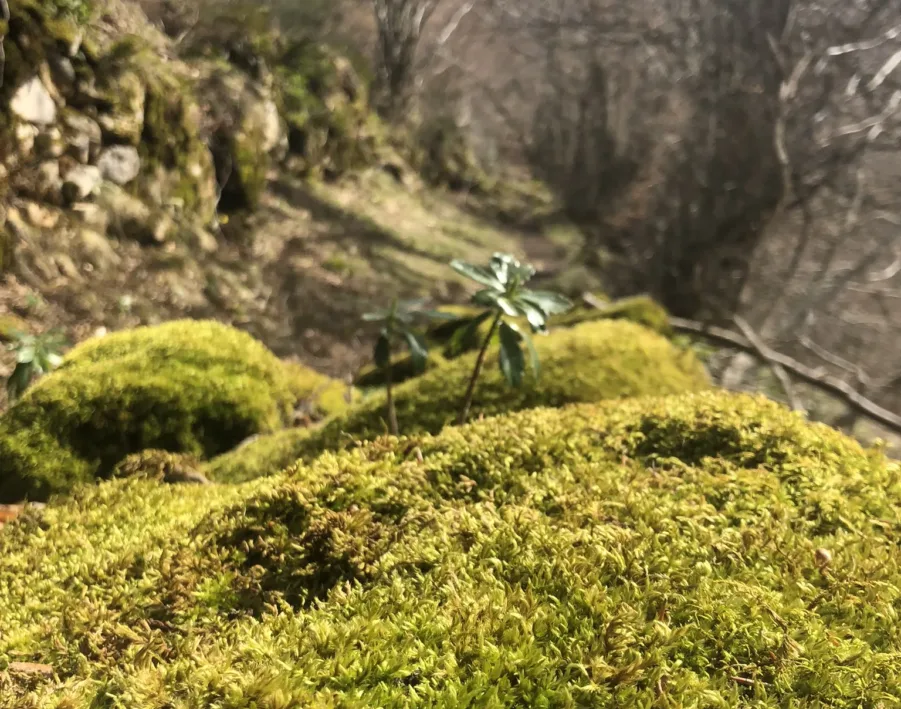Some of the most special things in nature are the ones that we overlook most often. It’s easy to take some forms of wildlife for granted, especially the ones that are small, or ever-present. Mosses certainly fall under this category. Amidst the flashy green of other plants, it’s easy to lose sight of these widespread but understated features.
But what exactly are mosses? In this Wildlife Spotlight post, let’s get to know these fascinating organisms and their role in natural spaces.
Are mosses plants?

One of the first questions to come to mind with regard to mosses is whether or not they are plants. The short answer is yes, but as you might guess, the long answer is way cooler.
Mosses are plants, but specifically they are one of several groups of non-vascular plants called bryophytes. This means that they don’t have the xylem and phloem that other plants use to carry water and nutrients around inside of them. Instead, they absorb water and nutrients directly through their cell walls.
Because of this, it can be helpful to think of mosses as the amphibians of the plant world. Similarly to amphibians, especially ones like lungless salamanders (family Plethodontidae) they absorb everything through their skin! This key difference has major implications for how they live their lives. Also similar to amphibians, mosses are much older than their relatives, the vascular plants. In fact, mosses are truly ancient. The earliest mosses may have lived up to 450 million years ago!
Staying hydrated
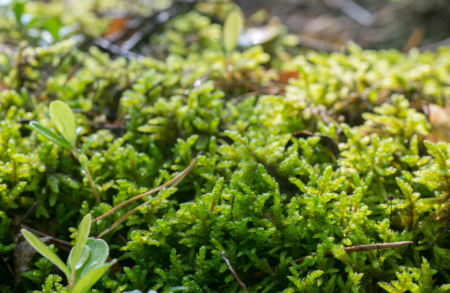
Folks will tell you that staying hydrated is the key to good health. As Bob and I discussed in our Nature Guys episode “What the Heck is Water?”, no living things on Earth get far without it. Because of this, mosses live very different lives than plants capable of harvesting and distributing water via roots and vasculature.
Lacking roots to search for moisture and vessels to move that water around inside of them, mosses can’t grow as large as plants. If they grew very tall or far, moving away from a source of moisture, they wouldn’t be able to get water to their tissues. That would cause those parts of the moss to die. Scientists call mosses poikilohydric, meaning that their internal moisture depends on how wet it is outside their bodies.
So, instead of towering high in the canopy, they are generally small in stature. While they don’t have roots capable of drawing moisture, they do have rootlets which help anchor them where they sit. This is why mosses are so good at clinging to trees, brick walls, and other surfaces where they settle. Most mosses are typically less than an inch to several inches tall. The mightiest among them, Dawsonia, reaches a whopping 20inches (51cm), still barely reaching most people’s knees.
The need to stay hydrated also influences where you’ll find mosses out in the natural world.
Where to find moss

This key difference also influences where you can find them. Mosses tend to prefer moist microhabitats where the moisture they need is readily at hand (or at leaf?). Because of this, you will find them in wet places like:
- waterfalls
- under trees, especially in forests
- vernal pools
- caves
- streams and riversides
- bogs and other wetlands
Of course, they can also grow in lots of other places, including rather dry ones. Some moss species accomplish this by being capable of drying out completely, and going dormant. This is analogous to the way that some plants and animals survive the winter. When rain does occur, these mosses can revive quickly and continue photosynthesizing. More complex vascular plants, with the exception of species like the resurrection fern (Polypodium polypodioides), can’t do this very well.
Many mosses cling to trees in places where there is sufficient moisture for them to survive. In temperate climates, they are often among the most common epiphytes!
Simple but effective

As we’ll learn further on, the way that mosses reproduce also makes it easier for them to colonize new habitats. Because of this, they are common successional species that show up first when new habitats are available. This means you can even find some species in heavily disturbed areas like forests after wildfires.
Their simple design can make some mosses incredibly hardy. This means that they can withstand conditions that other plants cannot. For instance, Ceratodon purpureus is an extremely widespread moss in human-built environments. It can survive on poor soil, rocks, sidewalk pavement, and even the sides and roofs of buildings!
Does moss grow on the North side of trees?

Although this may seem like a myth fit for a Biologist Ruins Everything post, depending on where you are, this is generally true. Since mosses prefer more moist areas, they will concentrate in places where the drying influence of the sun is not as strong. In the Northern Hemisphere, this is typically on the North-facing side of trees, buildings, or mountains. Of course, the effect is the opposite in the southern hemisphere.
Do mosses have seeds?
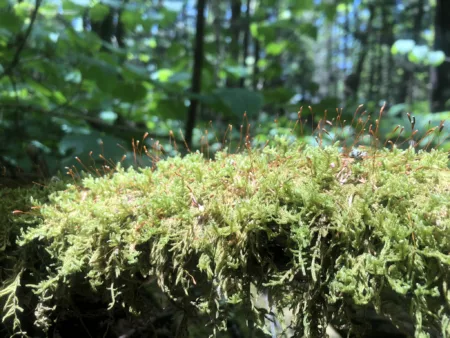
Unlike vascular plants, mosses do not have seeds. This is a result of their very different lifestyle. Rather than flowering and producing seeds, mosses produce spores. These tiny particles contain the necessary cellular machinery to start a new moss. Instead of the usual modes of seed dispersal employed by other plants, spores are largely wind-bound.
A small gust can move these spores many miles, and they can quickly start a new life if they settle in a favorable location. Mosses can also reproduce if they are split into pieces, with each piece growing independently in a new spot. This may happen when animals disturb mosses through foraging or trampling.
Alternation of generations
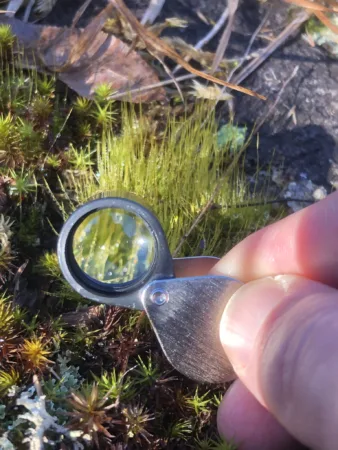
Moss’ different lifestyle doesn’t end with spores. The whole process leading up to them is very different from vascular plants. Technically, all plants have two basic forms during their life cycle:
- The gametophyte, which has only one copy of the plants’ DNA, which his called being haploid. This produces the eggs and sperm for reproduction.
- The sporophyte, which is diploid or has two copies of the DNA. It comes from the embryo produced by the egg and sperm coming together.
When you look at the wall of green made up by larger plants and trees during Spring and Summer, you’re looking mostly at the sporophyte form of the plant. Like you and I, this grew from an embryo resulting from an egg and sperm getting together. The gametophyte phases of most plants are tiny and occur inside of their reproductive structures, for example flowers or cones.
Taking the opposite route
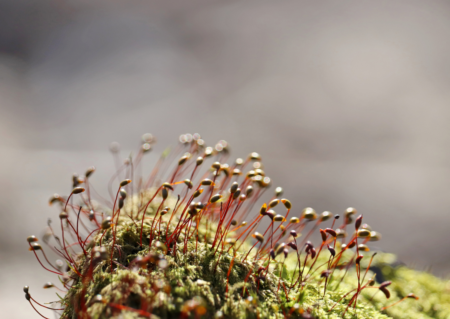
With mosses, the major “green thing” you see is actually the haploid gametophyte, which only has one copy of the moss’ DNA. These produce swimming sperm that can move between moss plants when it rains. While this means that mosses don’t rely on pollination to reproduce, they can’t do it without the occasional rain.
The resulting embryo becomes the moss sporophyte, which usually grows on a long stalk up above the plant. An organ known as the sporangium produces tiny spores at the top. Just like fungal spores, these blow away in the wind and can travel huge distances. Because of this, mosses don’t need animals to move their spores around like many plants with seeds. Furthermore, those wind-blown spores can settle all over the place, and start a new moss plant wherever conditions are favorable and wet enough.
The sporophyte is a temporary structure, while the rest of the moss is present year-round. Using a magnifying glass is a great way to check out these different parts of the moss.
Their role in the ecosystem
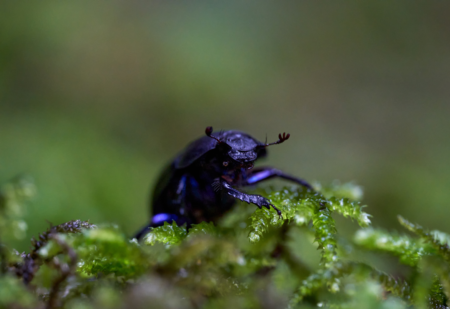
Like any other form of wildlife on earth, mosses are related to other living things in the ecosystem, including as part of the food chain. Plenty of invertebrates, and even some mammals will consume moss. By absorbing and retaining water, mosses also help maintain moist micro-habitats for other moisture-loving animals.
They can also gradually pave the way for plants to reclaim areas that have been cleared by wildfire, erosion, or other disturbances. Using their rootlets to hold on tight, mosses also hold pieces of soil together, stabilizing the ground and keeping it moist, making it better habitat for other young plants. Their tiny spores, capable of traveling thousands of miles on the wind, help mosses always show up first when new habitats open up. That makes them the vanguard of any new ecosystem popping up!
Fascinatingly, research suggests that animals can help mosses fertilize their spores the way that pollinators help flowers. Springtails, which often inhabit and feed upon mosses, may both increase fertilization and disperse moss spores as they move about.
Thanks for reading!
Do you have a favorite moss? We’d love to hear about it in the comments! if you have questions about moss or want to request a post for Gulo in Nature, drop us a line using the Contact page or reach out via Social Media.

